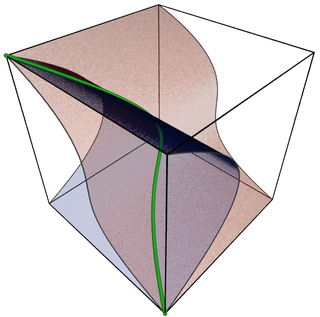Related Research Articles

Algebraic geometry is a branch of mathematics which uses abstract algebraic techniques, mainly from commutative algebra, to solve geometrical problems. Classically, it studies zeros of multivariate polynomials; the modern approach generalizes this in a few different aspects.

Algebraic varieties are the central objects of study in algebraic geometry, a sub-field of mathematics. Classically, an algebraic variety is defined as the set of solutions of a system of polynomial equations over the real or complex numbers. Modern definitions generalize this concept in several different ways, while attempting to preserve the geometric intuition behind the original definition.
In mathematics and specifically in algebraic geometry, the dimension of an algebraic variety may be defined in various equivalent ways.
In mathematics, and more specifically in computer algebra, computational algebraic geometry, and computational commutative algebra, a Gröbner basis is a particular kind of generating set of an ideal in a polynomial ring K[x1, ..., xn] over a field K. A Gröbner basis allows many important properties of the ideal and the associated algebraic variety to be deduced easily, such as the dimension and the number of zeros when it is finite. Gröbner basis computation is one of the main practical tools for solving systems of polynomial equations and computing the images of algebraic varieties under projections or rational maps.
Invariant theory is a branch of abstract algebra dealing with actions of groups on algebraic varieties, such as vector spaces, from the point of view of their effect on functions. Classically, the theory dealt with the question of explicit description of polynomial functions that do not change, or are invariant, under the transformations from a given linear group. For example, if we consider the action of the special linear group SLn on the space of n by n matrices by left multiplication, then the determinant is an invariant of this action because the determinant of A X equals the determinant of X, when A is in SLn.
In geometry, a hypersurface is a generalization of the concepts of hyperplane, plane curve, and surface. A hypersurface is a manifold or an algebraic variety of dimension n − 1, which is embedded in an ambient space of dimension n, generally a Euclidean space, an affine space or a projective space. Hypersurfaces share, with surfaces in a three-dimensional space, the property of being defined by a single implicit equation, at least locally, and sometimes globally.
In algebraic geometry, a toric variety or torus embedding is an algebraic variety containing an algebraic torus as an open dense subset, such that the action of the torus on itself extends to the whole variety. Some authors also require it to be normal. Toric varieties form an important and rich class of examples in algebraic geometry, which often provide a testing ground for theorems. The geometry of a toric variety is fully determined by the combinatorics of its associated fan, which often makes computations far more tractable. For a certain special, but still quite general class of toric varieties, this information is also encoded in a polytope, which creates a powerful connection of the subject with convex geometry. Familiar examples of toric varieties are affine space, projective spaces, products of projective spaces and bundles over projective space.

In mathematics, tropical geometry is the study of polynomials and their geometric properties when addition is replaced with minimization and multiplication is replaced with ordinary addition:

Bernd Sturmfels is a Professor of Mathematics and Computer Science at the University of California, Berkeley and is a director of the Max Planck Institute for Mathematics in the Sciences in Leipzig since 2017.
In mathematics, a complex line is a one-dimensional affine subspace of a vector space over the complex numbers. A common point of confusion is that while a complex line has complex dimension one over C, it has ordinary dimension two over the real numbers R, and is topologically equivalent to a real plane, not a real line.
Combinatorial commutative algebra is a relatively new, rapidly developing mathematical discipline. As the name implies, it lies at the intersection of two more established fields, commutative algebra and combinatorics, and frequently uses methods of one to address problems arising in the other. Less obviously, polyhedral geometry plays a significant role.

Algebraic combinatorics is an area of mathematics that employs methods of abstract algebra, notably group theory and representation theory, in various combinatorial contexts and, conversely, applies combinatorial techniques to problems in algebra.
In algebraic geometry, determinantal varieties are spaces of matrices with a given upper bound on their ranks. Their significance comes from the fact that many examples in algebraic geometry are of this form, such as the Segre embedding of a product of two projective spaces.
In mathematics, a Stanley–Reisner ring, or face ring, is a quotient of a polynomial algebra over a field by a square-free monomial ideal. Such ideals are described more geometrically in terms of finite simplicial complexes. The Stanley–Reisner ring construction is a basic tool within algebraic combinatorics and combinatorial commutative algebra. Its properties were investigated by Richard Stanley, Melvin Hochster, and Gerald Reisner in the early 1970s.
In mathematics, the Newton polytope is an integral polytope associated with a multivariate polynomial. It can be used to analyze the polynomial's behavior when specific variables are considered negligible relative to the others. Specifically, given a vector of variables and a finite family of pairwise distinct vectors from each encoding the exponents within a monomial, consider the multivariate polynomial
In mathematics invariant theory, the bracket ring is the subring of the ring of polynomials k[x11,...,xdn] generated by the d-by-d minors of a generic d-by-n matrix (xij).

David Archibald Cox is a retired American mathematician, working in algebraic geometry.
In abstract algebra, a monomial ideal is an ideal generated by monomials in a multivariate polynomial ring over a field.
Diane Margaret Maclagan is a professor of mathematics at the University of Warwick. She is a researcher in combinatorial and computational commutative algebra and algebraic geometry, with an emphasis on toric varieties, Hilbert schemes, and tropical geometry.
In mathematics, a polyhedral complex is a set of polyhedra in a real vector space that fit together in a specific way. Polyhedral complexes generalize simplicial complexes and arise in various areas of polyhedral geometry, such as tropical geometry, splines and hyperplane arrangements.
References
- ↑ Miller, Ezra; Sturmfels, Bernd (2005), Combinatorial Commutative Algebra, Graduate Texts in Mathematics, vol. 227, New York: Springer-Verlag, ISBN 0-387-22356-8
- ↑ Cox, David. "Lectures on toric varieties" (PDF). Lecture 3. §4 and §5.
- ↑ Sturmfels, Bernd (1996). Gröbner Bases and Convex Polytopes. Providence, RI: American Mathematical Society.
- ↑ Teissier, Bernard (2004). Monomial Ideals, Binomial Ideals, Polynomial Ideals (PDF).